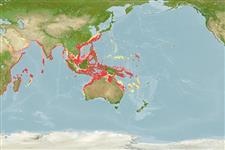Common names from other countries
Environment: milieu / climate zone / depth range / distribution range
Ecologie
marien; brak water rifbewoner; diepte 50 - 200 m (Ref. 47690). Subtropical; 32°N - 30°S, 30°E - 169°E
Indo-West Pacific: East Africa, as far south as Durban in South Africa, to southern Japan and northeastern Australia, east to New Caledonia.
Lengte bij maturiteit / Grootte / Gewicht / Leeftijd
Maturity: Lm 14.0 range ? - ? cm
Max length : 30.0 cm TL mannelijk / geslacht onbekend; (Ref. 47690); common length : 20.0 cm TL mannelijk / geslacht onbekend; (Ref. 47690)
Dorsale stekels (totaal): 3 - 4; Dorsale zachte stralen (totaal): 40-45; Anale stekels 0; Anale zachte stralen: 30 - 33. This species is distinguished by its very deep body, almost triangular, extremely compressed; sharp-edged breast; greatest body depth below lateral line at least 4 times greater than greatest body depth above lateral line; anal fin very long-based, commencing at point of insertion of pelvic fins, uniformly very low; dorsal spines (X in juveniles) reducing in number with increasing age. Colour of body with upper sides deep metallic blue, the rest silvery, a row of round to ovoid, dark slaty-blue spots above and below lateral line, sometimes a few additional spots above and below these rows; pelvic fins with a trace of blue, other fins hyaline or slightly dusky (Ref. 47690).
Inhabits deeper coastal waters near the bottom on both the continental shelves and around major island groups; sometimes in river estuaries (Ref. 47690, 48635). Found in schools (Ref. 47690, 48635). Feeds on benthic invertebrates (Ref. 5213). Readily dries in air without salting (Ref. 4375, 48635). Caught in trawls and by beach seine, but mainly by trawling, often incidentally. Marketed fresh and dried (Ref. 47690). Minimum depth from Ref. 30573.
Levenscyclus en paargedrag
Maturiteit | Voortplanting | Paaien | Eieren | Fecunditeit | Larven
Heemstra, P.C., 1984. Menidae. In W. Fischer and G. Bianchi (eds.) FAO species identification sheets for fishery purposes. Western Indian Ocean fishing area 51. Vol. 3. (Ref. 3465)
Status op de Rode Lijst van het IUCN (Ref. 130435)
CITES (Ref. 128078)
Not Evaluated
Gevaar voor de mens
Harmless
Gebruik door de mens
Visserij: commercieel
Tools
Speciale rapporten
Download XML
Internetbronnen
Estimates based on models
Preferred temperature (Ref.
115969): 19.8 - 27.6, mean 24.4 (based on 503 cells).
Fylogenetische diversiteitsindex (Ref.
82804): PD
50 = 1.5000 [Uniqueness, from 0.5 = low to 2.0 = high].
Bayesian length-weight: a=0.02089 (0.00843 - 0.05176), b=3.04 (2.82 - 3.26), in cm Total Length, based on LWR estimates for this (Sub)family-body shape (Ref.
93245).
Trofisch niveau (Ref.
69278): 3.5 ±0.41 se; based on food items.
Weerstandsvermogen (Ref.
120179): Hoog, minimale populatieverdubbelingstijd minder dan 15 maanden (K=0.19-1.2).
Fishing Vulnerability (Ref.
59153): Low vulnerability (17 of 100).
Climate Vulnerability (Ref.
125649): Low to moderate vulnerability (33 of 100).
